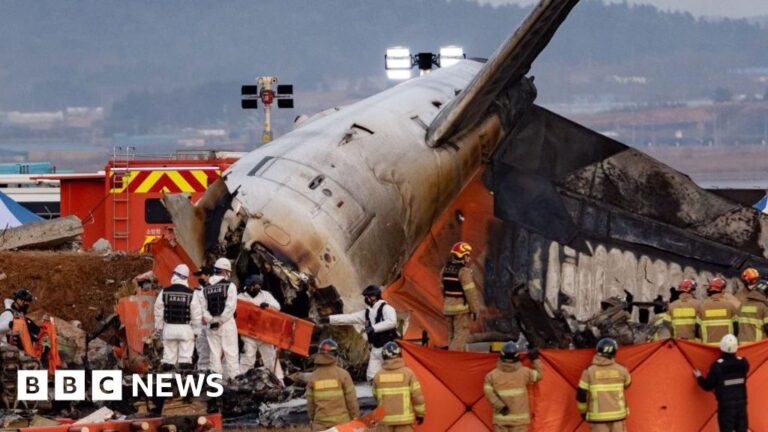South Korea will change concrete barriers used for navigation at nine airports across the country after a December plane crash that killed 179 people.
Seven airports will also have their runway safety zones adjusted following a review of all South Korean airports carried out after the accident, the deadliest in the country’s history.
The Jeju Air flight was bringing passengers back from Thailand after Christmas when it made an emergency landing at Muan Airport and exploded after hitting a concrete barrier at the end of the runway.
The cause of the crash is still unknown, but aviation safety experts previously said the number of casualties could have been much lower without the structure.
The concrete structure houses a navigation system that facilitates aircraft landings, called a locator. The South Korean Ministry of Transportation said that this system can also be found at other airports in the country and even abroad.
Safety inspectors have now identified nine such systems which they say need to be changed. These include the Muan systems and Jeju International Airport, the country’s second largest airport.
They are looking to either replace the concrete bases with lighter structures or bury them underground.
Officials added that the existing concrete mounds at Muan International Airport would be completely removed and the locator would be “reinstalled using breakable structures.”
Following the accident, it emerged that a Muan International Airport operations manual, posted online in early 2024, indicated that the concrete embankment was too close to the end of the runway.
The document, prepared by Korea Airports Corp, recommended that the location of the equipment be reviewed during a planned expansion.
Chris Kingswood, a pilot with 48 years of experience who flew the same type of plane involved in the accident, previously told the BBC that “obstacles within a certain range and distance of the runway must be frangible, which means if a plane hits them and they break.
As well as the barriers, seven airports will also have their runway safety zones adapted after the investigation found they were shorter than the recommended 240m (787ft).
The runway safety zone at Muan Airport was reportedly about 200 meters long.
A runway safety zone refers to an area adjacent to or at the end of a runway, intended to limit damage to aircraft in the event of overshooting, undershooting or deviation from the runway.
The 179 passengers on board the Boeing B737-800 ranged in age from three to 78, although most were between 40, 50 and 60. Two cabin crew members were the only survivors.
Investigators are still looking into the causes of the accident, but the pilot had warned of a bird strike before withdrawing from a first landing attempt. The plane crashed on its second landing attempt without the landing gear extending.
Flight data and cockpit voice recorders stopped recording four minutes before the disaster, a black box investigation later found.

